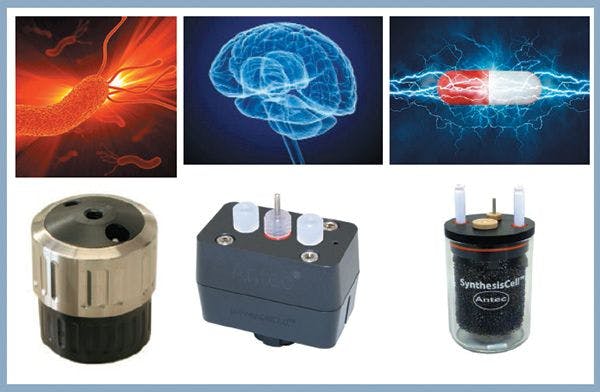Definitive EtG/EtS LC–MS/MS Analysis: A Rugged 4-Min Method for High-Throughput Laboratories
Special Issues
Methods for monitoring alcohol consumption biomarkers EtG and EtS are generally limited by poor retention and coelution with matrix interferences, as well as by long analysis times and short column lifetimes. The dilute-and-shoot EtG/EtS LC–MS/MS analysis developed here using the novel Raptor EtG/EtS column easily resolves EtG and EtS from matrix interferences, providing consistent, accurate results for high-throughput labs testing human urine samples for alcohol consumption.
Ethyl glucuronide (EtG) and ethyl sulfate (EtS) are important biomarkers of alcohol use. The detection of these metabolites offers many advantages for abstinence monitoring, including a three-day detection window, good stability in properly stored specimens, and analytical specificity. However, typical methods for EtG/EtS analysis have several shortfalls: poor resolution of EtG and EtS from matrix components, long run times that limit sample throughput, and short column lifetimes.
In this study, a simple dilute-and-shoot method was developed, validated, and applied to patient samples for EtG/EtS LC–MS/MS analysis in human urine. The method was developed on a Raptor EtG/EtS column because it provides the retention characteristics that are needed to consistently elute the target analytes away from matrix interferences. In addition, it is rugged and long-lasting, which is beneficial to high-throughput laboratories.
Experimental Conditions
Standard and Sample Preparation
Human urine (alcohol free) was fortified with EtG and EtS in order to prepare calibration standards and QC samples. The concentration of calibration standards ranged from 50–5000 ng/mL for both analytes. Four QC levels were prepared at 50, 150, 750, and 4000 ng/mL.
Aliquots (50 µL) of urine were diluted with 950 µL of the working internal standard (100 ng/mL EtG-d5 and 25 ng/mL EtS-d5 in 0.1% formic acid in water). Samples were vortexed at 3500 rpm for 10 s to mix followed by centrifugation at 3000 rpm for 5 min at 10 °C. Additional double blanks were extracted for column equilibration.
LC–MS/MS Analysis
In order to ensure good response, peak shape, and retention time consistency, the analytical column was conditioned prior to use with 30 matrix injections that were run through the full gradient program. Instrument parameters for EtG/EtS LC–MS/MS analysis are shown below and the analyte transitions are given in Table I.


Results
Chromatographic Performance
As shown in Figure 1, a fast, 4-min EtG/EtS LC–MS/MS analysis was obtained from the direct (dilute-and-shoot) injection of supernatant. Both EtG and EtS are clearly resolved from matrix interferences, making accurate peak identification an easy task. Even after 1000 sample injections on a Raptor EtG/EtS column, all chromatographic peaks maintained the initial peak shape, retention time, and response.

Figure 1: Rugged Raptor EtG/EtS columns provide reliable results for EtG/EtS LC-MS/MS analysis allowing more samples to be analyzed between column changes.
Linearity
Using linear 1/x weighted regression for EtG and EtS, both compounds showed good linearity with r2 values of 0.999 or greater over a calibration range of 50–5000 ng/mL. Accurate calibration down to 50 ng/mL allows low-level positive results to be reported with confidence.
Accuracy & Precision
Precision and accuracy analyses were performed on three different days. The method accuracy was demonstrated to be within 6.3% of the nominal concentration for all QC levels for both EtG and EtS. The %RSD was 1.28–9.19% and 4.01–6.82% for intra- and inter-run, respectively, at the QC LLOQ. The %RSD was 0.675–7.78% and 1.00–4.99% for intra- and inter-run, respectively, at the QC low, mid, and high levels, indicating good method precision for EtG/EtS LC–MS/MS analysis (Table II).

Matrix Effect
Samples prepared in matrix show approximately 80% (EtG) and 100% (EtS) of the signal obtained when samples are prepared in solvent across all QC levels, demonstrating that matrix effect is minimal. The sensitivity and consistency of the EtG response at the LLOQ is only possible because retention on the Raptor EtG/EtS column was optimized so that EtG elutes outside the zones of matrix suppression (Figure 2). Because the optimal EtG elution time was established here during method development, clinical labs adopting the method can be confident that matrix suppression has already been minimized. This, in combination with the established calibration range and LLOQ, demonstrates that the method provides excellent sensitivity for EtG, which is generally harder to detect at low levels than EtS.

Figure 2: EtG elutes outside the matrix suppression zones (double blank injection with post-column EtG infusion).
Sample Analysis
The robustness of the method was further tested by monitoring five patient samples with positive results for both EtG and EtS in the lower end of the linear range across multiple instrument platforms and nine lots of Raptor EtG/EtS columns. The precision of the results (n=9) was found to range from 3.24–11.2% for both analytes over multiple days and sample preparations, indicating excellent robustness and ease of method transfer (Table III). High-throughput labs in particular will benefit from implementing this rugged EtG/EtS LC–MS/MS analysis method as highly consistent performance is seen across a wide range of scenarios.

Conclusions
It was demonstrated that the Raptor EtG/EtS column is excellent for the rapid and accurate analysis of EtG and EtS in human urine. Isobaric matrix interferences are easily resolved, preventing issues with peak identification and quantitation. In addition, superior sensitivity for EtG is achieved because it elutes outside the zones of matrix suppression that are typically observed with dilute-and-shoot assays. With a fast and simple sample preparation procedure and only 4 min of chromatographic analysis time, the EtG/EtS LC–MS/MS method established here provides accurate, high-throughput monitoring of alcohol consumption. For the full article, visit www.restek.com and enter "CFAN2736" in the search box.

Restek Corporation
110 Benner Circle, Bellefonte, PA 16823
tel. (800) 356-1688, fax (814) 353-1309
Website: www.restek.com















